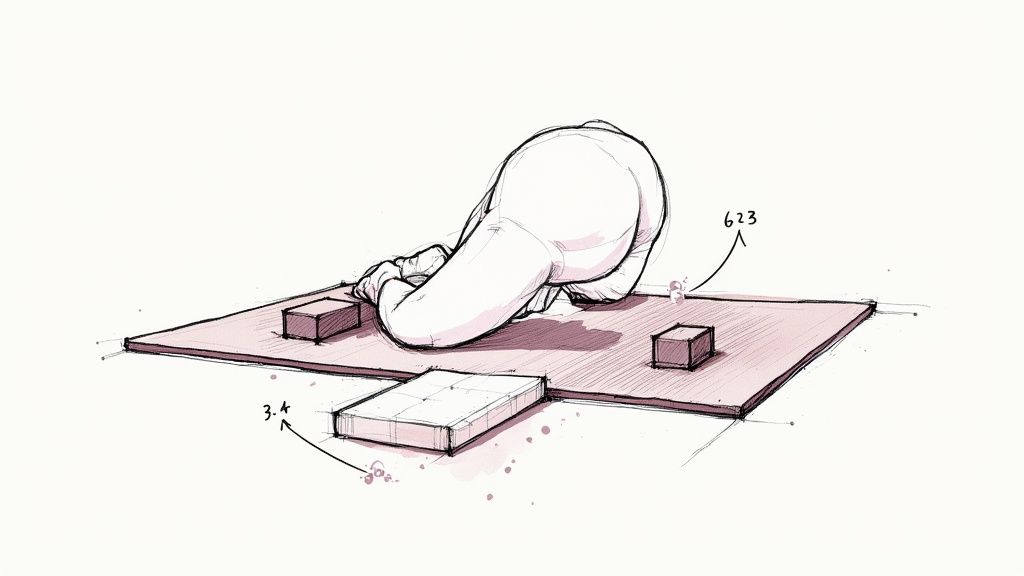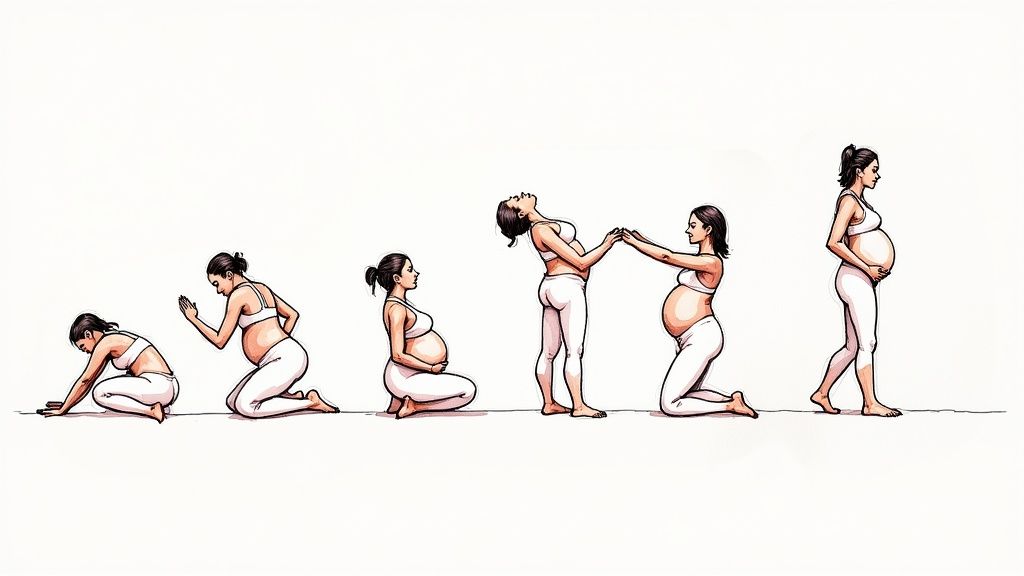Understanding the Real Impact of Prenatal Yoga
Regular prenatal yoga creates lasting positive changes for both body and mind during pregnancy. As you practice consistently, you’ll likely notice improvements in how you feel physically and emotionally. Let’s explore the specific ways yoga supports expectant mothers through each stage of pregnancy.
Physical Benefits: Strength, Flexibility, and Comfort
The physical practice of prenatal yoga helps prepare your body for labor and delivery. Poses like Warrior Two and goddess pose to build strength in your legs and hips – muscles you’ll rely on as your baby grows. Many women find that yoga helps ease common pregnancy discomforts like back pain by improving flexibility and balance. As your center of gravity shifts with your growing belly, yoga helps your body adjust naturally to these changes. Simple poses that boost circulation can also reduce swelling in the feet and ankles that many pregnant women experience.
Hormonal Harmony: Balancing Your System
The breathing exercises central to yoga practice help regulate important pregnancy hormones. Deep, mindful breathing reduces cortisol, your body’s main stress hormone, which is especially important since high cortisol can affect your baby’s development. At the same time, yoga triggers the release of endorphins – natural chemicals that boost mood and reduce anxiety. Making time for regular yoga practice helps create a more balanced pregnancy experience on a physiological level.
Mental and Emotional Well-being: Cultivating Calm
Pregnancy brings major emotional changes, and yoga offers practical tools for handling the ups and downs. The mindfulness aspects of prenatal yoga, from meditation to focused breathing, help you stay centered when emotions feel overwhelming. Something as simple as taking slow, deep breaths can quickly calm your nervous system when you’re feeling stressed. Many women also value the community aspect of prenatal yoga classes, where they can connect with others going through similar experiences. Resources like Pregnancy 101 provide online communities and expert guidance for additional support during pregnancy.
Preparing for Birth: Body and Mind
The physical and mental preparation from prenatal yoga directly supports the birthing process. Specific poses help open the pelvis and create flexibility in key muscles used during delivery. The breathing and relaxation techniques you learn become valuable tools for managing pain and staying calm during labor. This combined physical and mental preparation helps many women approach childbirth feeling more confident and capable. The skills developed through regular practice serve you well both during pregnancy and as you welcome your baby.
Building Your Mental Toolkit Through Yoga

Pregnancy brings many emotional changes, and practicing yoga offers both physical and mental support during this special time. Like packing a toolkit with useful items, yoga equips you with practical techniques to handle daily worries and the big life changes that come with expecting a baby.
Taming the Anxiety Monster: Breathing and Meditation
Your breath is one of the most effective tools for managing stress during pregnancy. Taking slow, deep breaths into your belly for just a few minutes can help lower stress hormones, creating a calmer environment for both you and your baby. Simple meditation practices, even brief 5-minute sessions, can quiet busy thoughts and bring a sense of peace. Many moms-to-be find that starting their day with gentle breathing exercises makes a noticeable difference in their mood.
Sleep Sanctuary: Restorative Yoga and Mindfulness
Many pregnant women struggle with sleep, which affects how they feel both physically and emotionally. Gentle yoga poses can help prepare your body and mind for better rest. Try doing some light stretches before bed to release tension. Beyond the physical aspects, practicing mindfulness by focusing on the present moment and letting thoughts drift by without judgment can help quiet a busy mind at bedtime. When combined, these gentle movements and mental relaxation techniques often lead to more restful nights.
Personalized Mindfulness: Finding Your Approach
Every woman experiences pregnancy differently, and what works for one may not work for another. Some find peace in guided meditations, while others prefer mindful walks or gentle movement. Try different approaches – maybe start with body awareness exercises or bring mindfulness to daily activities like eating. For more guidance and support, resources like Pregnancy 101 offer flexible classes and connect you with other expectant mothers who share similar experiences.
Integrating Yoga into Daily Life
You don’t need long yoga sessions to benefit from these practices. Small moments of mindful breathing or gentle stretching throughout your day can make a real difference. Try taking deep breaths during your morning commute, doing quick stretches on your lunch break, or practicing relaxation techniques before bed. These simple but regular practices help you handle pregnancy’s emotional ups and downs with greater ease, supporting both your physical and mental wellbeing as you prepare for motherhood.
Mastering Physical Comfort Throughout Pregnancy

When it comes to managing the physical changes of pregnancy, yoga offers practical tools and techniques that can make a real difference. Building on the mental and emotional benefits we discussed earlier, let’s look at how yoga helps address common pregnancy discomforts and supports your changing body.
Targeting Specific Discomforts with Yoga
Pregnancy brings many physical changes, from minor aches to major shifts in posture and balance. The good news is that specific yoga poses can help with common issues. For instance, gentle back bends and cat-cow stretches often ease lower back pain by releasing tight muscles and building core strength. Foot and ankle swelling, which many women experience due to increased blood volume, tends to improve with simple seated poses that boost circulation. Regular practice of these targeted poses can help manage daily discomfort and prepare your body for the months ahead.
Adapting Your Practice as Your Body Changes
Your yoga practice needs to evolve as your pregnancy progresses. Many women find they have decent energy for more active poses during the first trimester. But as your belly grows, you’ll need to make changes – like avoiding poses that require lying flat on your back after the fourth month, since this can reduce blood flow to your baby. Some movements, such as deep twisting poses, may need to be modified or skipped entirely in later months. The experts at Pregnancy 101 can guide you through safe modifications for each stage of pregnancy.
Maintaining Strength and Flexibility Safely
Just like a tree needs both strong roots and flexible branches to thrive, your pregnant body benefits from balanced strength and mobility. Regular prenatal yoga helps build the leg and hip strength needed to carry extra pregnancy weight while keeping your joints supple for labor. Standing poses like Warrior II strengthen your legs and improve balance – which becomes extra important as your center of gravity shifts. Meanwhile, gentle stretches help maintain the flexibility you’ll appreciate during delivery.
Finding Relief and Long-Term Comfort
The benefits of prenatal yoga extend well beyond temporary comfort. Research shows that women who practice yoga during pregnancy often have easier labors and lower rates of preterm delivery. One study found that regular prenatal yoga practice significantly reduced the risk of early labor. This likely stems from several factors working together: lower stress levels, better blood flow, and stronger pelvic floor muscles. Making yoga part of your pregnancy routine can help create a foundation for comfort that lasts throughout your journey to motherhood.
Navigating Practice Safety with Confidence
When practicing yoga during pregnancy, staying safe and feeling confident are essential parts of getting the most benefit from your practice. Let’s explore how to listen to your body, adjust poses appropriately, and make smart choices that work for you.
Understanding Normal Discomfort vs. Warning Signs
Just like any physical activity, prenatal yoga can cause some mild muscle soreness as your body adjusts to the movements. This is completely normal and expected. However, it’s important to know what signals require attention. Sharp pains, feeling dizzy or short of breath, or any vaginal bleeding mean you should stop and contact your doctor right away. Think of it like driving your car – a gentle hum is fine, but if you hear concerning noises, you’d want to get it checked out. The same goes for how your body feels during yoga.
Modifying Common Yoga Poses for Pregnancy
Many standard yoga poses can work well during pregnancy with some simple changes. For example, instead of deep twisting poses, try gentle open twists that give your growing belly plenty of space. If you usually do headstands or shoulder stands, you may want to skip these or find alternatives, especially as your balance changes. When doing forward bends, take your feet wider apart and keep your knees slightly bent to make room for the baby. Resources like Pregnancy 101 can show you specific ways to adjust poses for each stage of pregnancy.
Adapting to Specific Pregnancy Conditions
Every pregnancy is unique, and your yoga practice should reflect your personal situation. If you have conditions like preeclampsia or gestational diabetes, you’ll need to take extra precautions. Work closely with both your doctor and a qualified prenatal yoga teacher to create a practice that’s safe for your circumstances. They can help you choose the right poses and movements while avoiding anything that might cause problems.
Making Informed Decisions About Your Practice
The key to safe prenatal yoga is making smart choices based on good information. This starts with finding a qualified prenatal yoga teacher and paying attention to how your body responds. Research shows that regular prenatal yoga, when done properly, can actually help prevent early labor. As you practice, stay aware of what feels good versus what doesn’t, and don’t hesitate to modify or skip poses that don’t work for you. When you understand these basics, you can practice with peace of mind and enjoy yoga’s many benefits throughout your pregnancy.
Customizing Your Practice By Trimester

Your yoga practice needs to change along with your body during pregnancy. Each trimester comes with its own physical and emotional experiences that call for different approaches to stay comfortable and safe. Learning how to adapt your practice helps you get the most benefit throughout your pregnancy.
First Trimester: Nurturing and Grounding
The early weeks often bring morning sickness, tiredness, and mood swings. During this time, focus on gentle poses and movements that help you feel stable and supported. Taking time for restorative poses and breathing exercises can help ease these common first trimester symptoms.
- Focus: Easy flows, restful poses, breathing techniques for nausea
- Poses to Embrace: Child’s pose, cat-cow, wide-legged forward folds, supported savasana
- Poses to Modify or Avoid: Deep twists and inversions. Rest whenever you need to.
- Benefits: Less fatigue, reduced nausea, better emotional balance. Simple breathing exercises can calm your nerves and settle your stomach.
Starting with these basics gives you a strong foundation for the months ahead. Learning to work with your breath now will also give you helpful tools for managing stress later in pregnancy.
Second Trimester: Strength and Stability
Many women find new energy in the second trimester. This is a good time to build your strength and stamina as your baby grows. You can add more active poses while still keeping everything safe and steady.
- Focus: Building strength, standing poses, gentle hip opening
- Poses to Embrace: Warrior II, triangle pose, goddess pose, hip circles
- Poses to Modify or Avoid: Long holds lying on your back after month 4
- Benefits: Stronger legs and hips, better balance, birth preparation. This work helps support your changing center of gravity.
Regular practice during these middle months helps prepare your body for the final trimester. It builds physical and mental confidence that serves you well as pregnancy progresses.
Third Trimester: Preparation and Surrender
The last months focus on getting ready for labor and birth. With your growing belly, you’ll need more modifications to stay comfortable. This is the time to emphasize pelvic floor work, hip opening, and relaxation. Pregnancy 101 offers specific guidance for this important phase.
- Focus: Pelvic floor exercises, hip openers, relaxation, birth breathing
- Poses to Embrace: Butterfly pose, squats, pelvic tilts, gentle back stretches. Focus on deep breathing and relaxation.
- Poses to Modify or Avoid: Deep twists, inversions, anything uncomfortable
- Benefits: Prepares the pelvis for birth, eases back pain, reduces swelling, and promotes calm. Remember to listen to your body and rest often.
Adjusting your practice for each stage of pregnancy helps you stay active safely while preparing both body and mind for birth. A thoughtful approach lets you enjoy the benefits of yoga throughout these special nine months.
Preparing for Birth Through Targeted Practice
As your due date approaches, adapting your yoga practice helps maximize its benefits during pregnancy. Let’s focus on specific poses and breathing techniques that directly support what your body and mind need during labor and delivery. Building on the basics you’ve learned throughout your pregnancy, you’ll develop the skills to face birth feeling prepared and capable.
Building Strength and Endurance for Labor
Think of labor as running a marathon – your body needs proper training to perform its best during this intense physical experience. Key poses like Warrior II, Goddess Pose, and supported squats help build strength in your legs and hips while improving your balance as your center of gravity shifts. Regular practice of pelvic floor exercises, including Kegels, supports your growing baby and prepares these essential muscles for childbirth.
Mastering Breathing Techniques for Pain Management
Just as singers use breath control to sustain notes, specific breathing patterns help you stay focused and manage pain during contractions. Deep, rhythmic breathing techniques like Ujjayi breath can decrease pain and promote relaxation when practiced regularly in your third trimester. Working with experienced teachers at Pregnancy 101 helps perfect these techniques so they become second nature when you need them most during labor.
Cultivating Mental Focus and Relaxation
Birth involves not just physical but also emotional and mental challenges. Like focusing on each step while climbing a mountain, mindfulness practices through yoga help you stay present during intense moments. Meditation and guided relaxation create mental clarity that allows you to work with your body’s natural rhythms during labor. Studies show that women who practice mindfulness while pregnant feel less anxious and more satisfied with their birth experience.
Sample Yoga Sequence for Birth Preparation
- Butterfly Pose (Baddha Konasana): Opens the hips and promotes flexibility in the pelvic area.
- Supported Squats (Malasana Variation): Strengthens legs, improves pelvic floor strength, and encourages optimal fetal positioning.
- Pelvic Tilts: Relieves lower back pain and strengthens abdominal muscles.
- Cat-Cow Pose (Bitilasana Marjaryasana): Increases spinal mobility and eases back discomfort.
- Side-Lying Savasana: Promotes relaxation and encourages deep rest.
- Ujjayi Breathing Practice: Creates calm and prepares you for using breath during labor.
These targeted practices help prepare both your body and mind for a positive birth experience. The consistent practice of prenatal yoga builds physical strength, mental focus, and breathing awareness that serves you well during labor and delivery.
Looking for support on your pregnancy journey? Pregnancy 101 offers expert-led prenatal yoga classes designed specifically for expectant mothers. Join our community of moms-to-be and learn valuable skills for pregnancy and birth. Sign up now to experience the benefits of prenatal yoga with experienced teachers who understand your unique needs.

